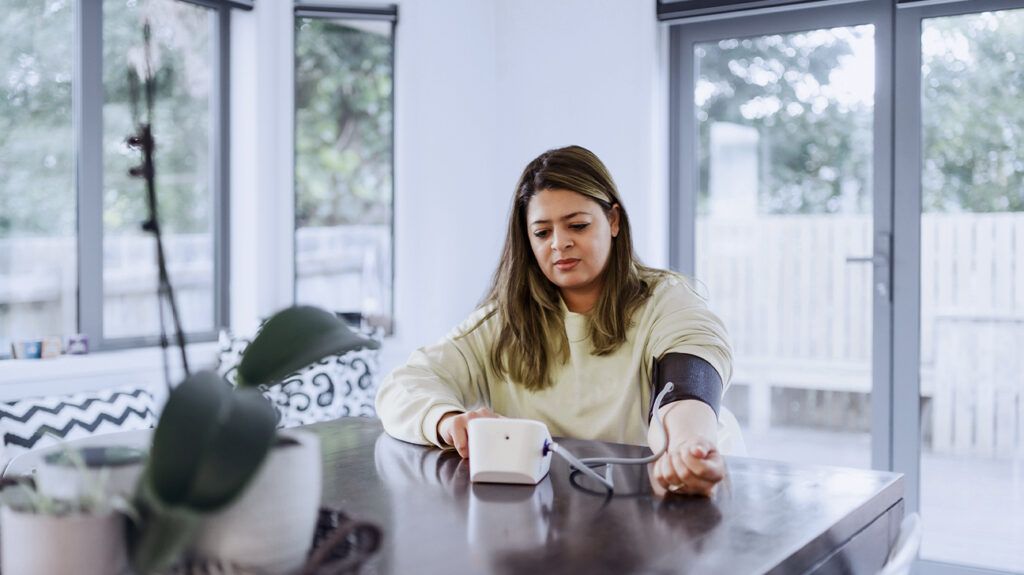Sleep bradycardia is a slow heart rate during sleep. It may be a natural, healthy sleep response or a sign of an underlying health issue. Another name for the condition is sinus bradycardia.
Most healthy adults have a heart rate between 60 and 100 beats per minute (bpm) at rest. Bradycardia means that the heart rate is slower than usual. What doctors consider too slow depends on a person’s age and physical condition. Physically active adults and athletes frequently have slower resting heart rates.
During sleep, it is common for the heart rate to
This article examines sleep bradycardia, its causes, risk factors, and management.

The body’s physiological functions undergo various changes during sleep. Most people experience a
Sleep bradycardia is generally considered
It is important to note that heart rates of 40 bpm to 60 bpm or lower can be common during sleep.
Certain drugs, such as beta-blockers, can also lower the heart rate during sleep.
Learn more about bradycardia.
Sleep bradycardia may be common for some individuals and cause no symptoms. However, an abnormally slow heart rate can lead to insufficient blood circulation around the body, particularly to the brain and vital organs. This reduced blood flow can cause symptoms
- lightheadedness
- fatigue and weakness
- shortness of breath
- fainting
- brain fog and confusion
- chest pain
Symptoms may not necessarily manifest during sleep.
Symptoms may also vary from person to person, and if bradyarrhythmia is persistent during the day, people may experience the symptoms above. People with sleep apnea may demonstrate snoring, apneic episodes, and nighttime awakenings.
If a person suspects that they or a loved one is experiencing symptoms of sleep bradycardia or sleep apnea, they may consult a doctor.
If a person has been diagnosed with bradycardia and notices any new or worsening symptoms related to sleeping patterns or overall health, they can check in with their healthcare professional. Timely evaluation can help identify underlying causes and guide appropriate management.
The heart relies on a network of specialized conduction pathways to ensure the smooth transmission of electrical impulses. These pathways allow for synchronized contraction of the heart’s chambers — called the atria and ventricles — and an efficient blood pumping action.
Sleep bradycardia is often a natural phenomenon that occurs due to increased vagal or parasympathetic tone. This refers to the activity of the vagus nerve, which plays a role in lowering heart rate. However, abnormal disruptions in the body’s mechanisms that control the heart rate can lead to pathologic sleep bradycardia.
These disruptions include dysfunction in the sinoatrial (SA) node, the heart’s natural pacemaker. When the SA node encounters issues, it can produce electrical impulses significantly slower than necessary, resulting in a lower heart rate.
Issues with the atrioventricular node can also play a role. This is a bundle of cells between the atria and ventricles that allows impulses to travel from the SA node to the heart’s lower chambers to generate the heartbeat.
Several risk factors can contribute to the development or worsening of bradycardia in sleep or wakeful periods. These may
- medications
- metabolic problems, such as low thyroid hormones (hypothyroidism)
- damage to the heart muscle due to aging, heart disease, or heart attacks
- inherited heart abnormalities
- myocarditis, or infection of the heart tissue
- potassium, calcium, or other chemical imbalances in the blood
- medical conditions, such as obstructive sleep apnea
- inflammatory diseases, such as rheumatic fever or lupus
Diagnosing sleep bradycardia involves a comprehensive evaluation by a healthcare professional. This assessment may
- a thorough medical history review
- physical examination
- specialized tests, such as electrocardiography (ECG or EKG)
- laboratory tests, including glucose level, electrolyte, calcium, magnesium, thyroid function, troponin, toxicological drug screen
- polysomnography to assess heart rate variations or specific rhythm disturbances during sleep, as well as brain activity and respiratory patterns
- portable heart rhythm monitor, such as Holter monitors, which capture heart rate for a period of time
screening for sleep apnea
Doctors may recommend overnight monitoring to capture the heart’s activity during sleep.
The treatment of sleep bradycardia depends on its underlying cause and the severity of symptoms.
Many people require no treatment as it is a typical finding during sleep and tends to cause no symptoms. Slight or occasional bradycardia may not always require treatment.
Medical intervention is sometimes necessary for bradycardia. This
- addressing underlying health conditions, such as sleep apnea, to alleviate the bradycardic episodes
- modifying a person’s medication regimen if there is a potential risk associated with certain drugs
- for severe cases, a pacemaker to regulate the heart’s rhythm
Effective management of sleep bradycardia involves close collaboration with healthcare professionals. This may include:
- regular follow-up appointments
- monitoring heart rate and symptoms over time
- adjusting treatment plans as necessary
Lifestyle modifications are also crucial to long-term management. These may include maintaining a healthy sleep routine and managing underlying risk factors.
A slower heart rate during sleep characterizes sleep bradycardia. In some people, it is a typical finding that causes no symptoms. For others, sleep bradycardia could signal sleep apnea or heart problems.
Bradycardia occurs due to changes or abnormalities in the typical regulatory mechanisms that control heart rate.
If a person experiences symptoms such as fatigue, dizziness, or chest pain, they can contact their doctor for a comprehensive evaluation.
